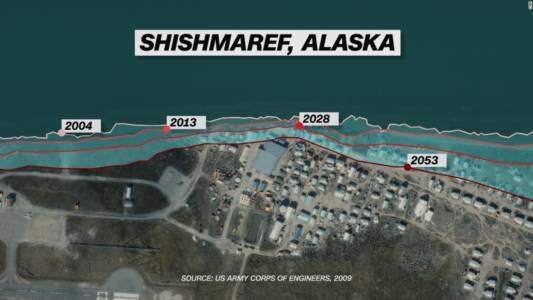Climate Change and Endangered Languages
There are about 7000 different languages in the world, and each has its own unique features that to users of another language may seem highly exotic, like the oft-told story that the Inuit have dozens of different words for ‘snow’. This infinite variability makes working with languages very interesting.
Sadly, about half of the world’s 7000 languages are expected to go extinct by the end of this century. You’ve probably heard of some causes: adoption of dominant languages, globalization, migration, underfunding, and sometimes outright suppression. News to me is that climate change is now a recognized factor threatening the survival of certain languages. And with the loss of each language, we are losing a unique way of talking about the world around us, and some of that infinite variability that makes language so interesting.
Takuu
Let’s take the Takuu language. Also known as Mortlock, it’s a Polynesian language spoken by some 1700 people, most notably the 400 inhabitants of the atoll of Takuu, in the Pacific Ocean. Takuu has some absolutely unique features. For example, Takuu speakers use a highly specific counting system that uses different words for numbers, depending on whether they’re counting fish, coconuts, people, canoes, lengths of rope, lengths of wood, net mesh, coin money, or something else! No kidding. Takuu is also unique in its egalitarian culture and in still holding on to a traditional Polynesian religion.

But most of Takuu is only 1 meter above sea level. The population is already struggling with a shrinking shoreline and the effects of sea level rise. Extreme weather events are increasing in frequency. A major flood in recent years destroyed over half the houses on the island. People have started to move away. The Papua New Guinea government has relocated many Takuu people to the town of Buka, on the much larger island of Bougainville. But Takuu speakers who have moved to Buka are rapidly losing their language and culture. And so, a unique language and culture are at risk of being washed away by climate change.
Inupiaq
Closer to home, let’s look at Inupiaq. It’s an “Eskimo” language spoken by about 2000 people in the far north of Alaska. It has four distinct dialects, each written in its own slightly different alphabet, and each in turn subdivided into subdialects. Inupiaq has grammatical and phonological features complex enough to make your head spin. Surprisingly, you probably know a few Inupiaq words, though! ‘Nanuq’ means polar bear, and ‘iglu’ means house!

During much of the twentieth century, the use of Inupiaq was forbidden, and education was English-only. Things changed for the better in the 1970s, and since a few years ago Inupiaq is now one of 20 official languages of the State of Alaska. Facebook even added an Inupiaq language option earlier this year!
Nevertheless, climate change threatens the Inupiaq language. This is clearly illustrated by recent events in the barrier island town of Shishmaref, home to some 500 Inupiat people. Rising temperatures are melting the permafrost on which the town is built, and reducing the sea ice that protects Shishmaref from erosion by the ocean waves. In recent years, the shoreline has been receding by 3 meters (!) per year. The projection in the image below shows how much of the town will be gobbled up by the waves 10 years from now, and 35 years from now.


The people of Shishmaref are under no illusion that there’s a future for their barrier island life. In 2016, they voted to move the town to the mainland. Where the money will come from is anybody’s guess.
Other Languages at Risk
When you dig deeper, there are many examples like Takuu and Inupiaq. Gilbertese, the Micronesian language spoken on Kiribati, is at risk of suffering the same fate as Takuu. So are Tuvaluan, Bislama (a creole language spoken on Vanuatu), and even Marshallese, despite still having a healthy number of active speakers today.
Nor is Inupiaq the only “Eskimo” language at risk. So are Inuktitut, Inuinnaqtun and Inuvialuktun. So are the Yupik languages, which are shared between the people of far western Alaska and far eastern Siberia.
In contrast, the official language of Greenland, Kalaallisut (or Greenlandic), appears to be in good shape with 50,000 speakers. But under the influence of climate change, Greenland’s permafrost has begun to melt, and the melting permafrost is making the country’s oil and gas reserves more accessible. This in turn is leading to an influx of workers from abroad. Estimates of how many non-Greenlandic workers might arrive vary wildly, from 2000 to 200,000. The high end is four times the entire population of Greenland. Kalaallisut could be at risk not because its native speakers are moving away, but simply because they might be completely outnumbered.
While most of us will probably never encounter these languages on even our most exotic travels, we can all appreciate how their very existence makes the world a more interesting place. And each time one of these unique languages blinks out under pressure from climate change, our world is left a little bit poorer.
Further Reading
https://theconversation.com/amp/the-impact-of-climate-change-on-language-loss-105475
https://www.k-international.com/blog/climate-change-and-endangered-languages/
https://grist.org/justice/as-ice-melts-and-seas-rise-can-endangered-languages-survive/
In her spare time, Miranda Glasbergen is a 350 volunteer serving on the 350 Denver Leadership Council. In day job, she manages terminology and translatability in the translation department of a global software company.


